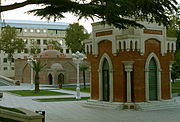| Chokak Hamam (Bath) | |
|---|---|
| Native name Çökək hamam (Azerbaijani) | |
 | |
| Location | Ganja, |
| Coordinates | 40°40′38″N 46°21′30″E / 40.6773°N 46.3582°E / 40.6773; 46.3582 |
| Built | 1606 |
| Original use | Bath |
| Restored | 2003 |
| Architect | Sheikh Bahaddin Mahammad Amil |
| Governing body | Vego Hotel, Ganja |
| Owner | Vego Hotel, Ganja |
 | |
Chokak Hamam (Azerbaijani: Çökək hamam, "fallen bath") is a historical bath near Juma Mosque in Ganja. Historical-architectural monument built in 1606 , by order of Shah Abbas.
The bathhouse was included in the list of immovable historical and cultural monuments of local significance by the decision No. 132 of the Cabinet of Ministers of the Republic of Azerbaijan on August 2, 2001.
About
Naming
The Chokak hamam is known by various names among the city's population. Since it was built by the order of Shah Abbas I, it is sometimes called the "Shah Abbas hamam." Due to its proximity to the Shah Abbas Mosque, it is also referred to as the "Mosque Bathhouse," and later it became known as the "Haji Alakbar Bathhouse" after the person who operated it. The name "Chokak " (meaning "sunken") comes from the fact that the bathhouse was built in a sunken area to ensure water pressure.
History
After the completion of the Juma Mosque in 1606, by the order of Safavid ruler Shah Abbas I, the construction of the Chokak Bathhouse began nearby. The architect of the bathhouse was Sheikh Bahaeddin, who was also the architect of many monuments in Ganja.
Architecture
In the construction of the bathhouse, traditional materials of the time were used, such as red bricks, egg whites, clay, and a lime-based binding mixture. The bathhouse consists of two interconnected halls. Inside the larger hall, there is a pool and a fountain, while the smaller hall is designated for washing. The bathhouse has two large domes and five smaller domes. Semi-domes, which serve as ventilation, were built around the large domes. The bathhouse remains warm in the winter and cool in the summer. In the basement, there were two steam boilers heated by wood. Steam was distributed to the halls through ceramic pipes embedded in the walls and floors, ensuring even heat circulation throughout all the rooms. This system remained in use until 1963.
After Azerbaijan regained its independence, in 1996, artist Galib Baghirov established a Decorative Applied Arts Center within the bathhouse, where he created and exhibited ceramic pottery.The bathhouse was included in the list of immovable historical and cultural monuments of local significance by the decision No. 132 of the Cabinet of Ministers of the Republic of Azerbaijan on August 2, 2001.
Restoration
The monument was restored in 2013, with efforts made to preserve its historical authenticity. The restoration work was carried out using old bricks, and the damaged dome and roof were repaired. After the restoration, the bathhouse became operational again. However, its use by a hotel and the fact that access to the bathhouse is only available through the hotel has been met with public disapproval.
Gallery
See also
References
- "Historical Monuments in Ganja". Archived from the original on 2019-10-21. Retrieved 2017-08-25.
- "Çökək hamam: Gəncədə səfəvi şahının 400 illik yadigarı". gencexeber.az (in Azerbaijani). 2021-10-02. Archived from the original on 2023-02-02. Retrieved 2024-09-26.
- ^ "Hamam (Çökək Hamam)". irs.gov.az. Archived from the original on 2023-06-01. Retrieved 2024-09-26.
- ^ Məmmədov, Mərdan (2021). Gəncə abidələri (in Azerbaijani). Bakı: Azərnəşr. p. 26. Archived from the original on 2024-09-18. Retrieved 2024-09-17.
- Gəncənin maddi mədəniyyət abidələri (in Azerbaijani). Bakı: Nurlan. 2004. p. 49. Archived from the original on 2024-09-19. Retrieved 2024-09-19.
- ^ Məmmədov, Elcan (2023-01-25). "Gəncədə XVII əsrin möhtəşəm memarlıq əsəri – "Çökək hamam"". Azərbaycan Dövlət İnformasiya Agentliyi. Retrieved 2024-09-26.
- Xəlilov, Zabit (2024-05-24). "Əsrlərin yadigarı - Çökək hamam". Respublika qəzeti (in Azerbaijani). Archived from the original on 2024-09-26. Retrieved 2024-09-26.
- "Azərbaycanın qədim hamamlarının dəbdəbəsi" (in Azerbaijani). 2018-09-13. Archived from the original on 2019-10-21. Retrieved 2019-10-23.
- İbrahimov, Natiq. "Gəncədə çökək hamam". azerbaycan-ruznamesi.org. Retrieved 2024-09-26.
- Muradov, Zakir (2019-06-08). "Tanınmış gəncəli rəssam vəfat etdi". 525-ci qəzet. Archived from the original on 2024-09-26. Retrieved 2024-09-26.
- "Azərbaycan Respublikası Nazirlər Kabinetinin 2001-ci il 2 avqust Tarixli 132 nömrəli qərarı ilə təsdiq edilmişdir" (PDF) (in Azerbaijani). mct.gov.az. 2001-08-02. Archived from the original (PDF) on 2021-07-07. Retrieved 2022-12-14.
- "Gəncənin tarix yadigarlarından – "Çökək hamam"". www.medeniyyet.az. 2023-01-27. Archived from the original on 2024-09-26. Retrieved 2024-09-26.
- ""Çökək hamam"da təmir-bərpa işləri davam edir" (in Azerbaijani). 2013-09-13. Archived from the original on 2019-10-21. Retrieved 2019-10-23.
- "Tarixi memarlıq nümunəsi hamamda mənəvi dinclik | Azerbaijan.Travel". azerbaijan.travel (in Azerbaijani). Archived from the original on 2024-09-18. Retrieved 2024-09-26.
- Nərimanoğlu, Osman (2020-06-06). ""V&GO" Hotel və milyonçu sahibi Gəncədə tarixi abidəni - "Çökək hamam"ı necə işğal edib?". demokratik.az. Retrieved 2024-09-26.
- "Gəncədə 17-ci əsrə aid "Çökək hamam" sakinlərin üzünə bağlıdır". gencexeber.az (in Azerbaijani). 2021-08-05. Archived from the original on 2023-09-27. Retrieved 2024-09-26.
- Zaur (2021-03-10). "Gəncədə 415 yaşlı tarixi abidə sauna kimi istifadə olunur". demokrat.az. Archived from the original on 2024-09-26. Retrieved 2024-09-26.



